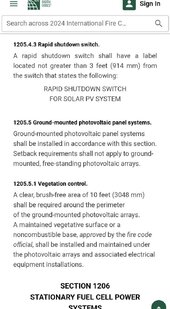rmassuser
New Member
I'm about to mount 6 Bluesun panels on a hill in my yard. Bifacial 460kwh.
I will need to get it permitted because it will be tied back to my house to my EG4 6000xp, and it will have a shutdown capability using Tigo monitor units.
While I have seen several videos with panels mounted on wood (i.e. solar pergola), I just noticed that there is a fire code in MA that assumes the panels could start a fire and it may require a non combustible base. And a "vegetation management plan"
Ok, should I put a layer of asphalt shingles on top of a 21 foot beam so I have a 4" x 252" 'roof' ?
Anyone have suggestions on what I can do to get this permitted?
I could paint the wood with intumescent paint but I suspect these paints are not outdoor rated.
The reason I want to use wood is mainly for appearance. I think my neighbors would appreciate my plan to work the panel into an existing structure. The alternative would be putting a big metal structure in the middle of the lawn, an eyesore.
My plan is mounting the panels above a wood fence by beefing up 3 of the posts to 6x6 lumber. That should be sufficient, with appropriate bracing, to hold six 60 pounds panels.
The only issues that might stop me is the requirement that a solar array have a noncombustible base (see 2017 and 2024 fire codes, I've attached as 2024 excerpt) and have a vegetation management plan. Also It's not clear whether I need a DC disconnect or stop button at the array, since I will have a stop button mounted 60 feet away on my garage. I may need a locked, outdoor rated junction box (not sure) that would provide a way to physically disconnect the array without getting up on a ladder, once I have activated the other disconnects and shutdown systems.
I will need to get it permitted because it will be tied back to my house to my EG4 6000xp, and it will have a shutdown capability using Tigo monitor units.
While I have seen several videos with panels mounted on wood (i.e. solar pergola), I just noticed that there is a fire code in MA that assumes the panels could start a fire and it may require a non combustible base. And a "vegetation management plan"
Ok, should I put a layer of asphalt shingles on top of a 21 foot beam so I have a 4" x 252" 'roof' ?
Anyone have suggestions on what I can do to get this permitted?
I could paint the wood with intumescent paint but I suspect these paints are not outdoor rated.
The reason I want to use wood is mainly for appearance. I think my neighbors would appreciate my plan to work the panel into an existing structure. The alternative would be putting a big metal structure in the middle of the lawn, an eyesore.
My plan is mounting the panels above a wood fence by beefing up 3 of the posts to 6x6 lumber. That should be sufficient, with appropriate bracing, to hold six 60 pounds panels.
The only issues that might stop me is the requirement that a solar array have a noncombustible base (see 2017 and 2024 fire codes, I've attached as 2024 excerpt) and have a vegetation management plan. Also It's not clear whether I need a DC disconnect or stop button at the array, since I will have a stop button mounted 60 feet away on my garage. I may need a locked, outdoor rated junction box (not sure) that would provide a way to physically disconnect the array without getting up on a ladder, once I have activated the other disconnects and shutdown systems.



